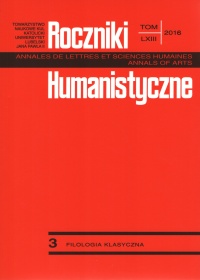The mysterious ‘movements’ in De generatione animalium IV 3, or the female in Aristotle’s theory of inheritance
Abstract
In this paper I discuss the problem of the role of female in Aristotle’s theory of inheritance described in De generatione animalium, book IV, chapter 3. Although in the books I-III Aristotle presents his well-known view that the male contributes form and the principle of movement whereas the female only matter, in the much discussed chapter IV 3 we are told that the offspring is shaped by the „movements” (kineseis) of both parents; these „movements”, contained in the „semens” (spermata) are derived from various potentials (dynameis) of organism’s nature, and function as specialised vehicles for transmitting the parts of the parent’s heritable form during the act of reproduction. In the paper I try to prove that the term spermata in this chapter denotes both male and female reproductive residues, and the matter contributed by the female (katamenia) contains potentially the nutritive soul with a set of „movements” responsible not only for the development of the female sex and the inherited accidental, material features, but also of the universal, i.e. the common form of the species.
References
Aristotelis: Opera ex recognitione Immanuelis Bekkeri, editio altera quam curavit O. Gigon, Berolini 1960.
Aristotle: Generation of Animals with an English translation by A.L. Peck, The Loeb Classical Library 1953.
Arystoteles: Dzieła wszystkie, t. I-VI, Warszawa 1990-2001.
Balme D.M.: Aristotle’s biology was not essentialist, w: Philosophical Issues in Aristotle’s Biology, s. 291-312.
Balme D.M.: Matter in the Definition. A reply to G.E.R Lloyd, w: Biologie, logique et métaphysique chez Aristote, s. 49-54.
Biologie, logique et métaphysique chez Aristote, ed. D. Devereux, P. Pellegrin, Paris 1997.
Coles A.: Biomedical Models of Reproduction in the Fifth Century BC and Aristotle’s Generation of Animals, „Phronesis” 40(1994), nr 1, s. 48-88.
Cook K.C.: Sexual Inequality in Aristotle’s Theories of Reproduction and Inheritance, w: Feminism and Ancient Philosophy, s. 51-67.
Cooper J.M.: Metaphysics in Aristotle’s Embryology, „Proceedings of the Cambridge Philological Society” 34(1988), s. 14-41.
Discovering Reality (Second Edition): Feminist Perspectives on Epistemology, Metaphysics, Methodology, and Philosophy of Science, ed. S.H. and M.B. Hintikka, Kluwer Academic Publishers 2003.
Feminism and Ancient Philosophy, ed. J.K. Ward, New York–London 1996.
Furth M.: Specific and Individual Form in Aristotle, w: Biologie, logique et métaphysique chez Aristote, s. 85-111.
Henry D.: Aristotle on the Mechanism of Inheritance. „Journal of the History of Biology” 39(2006), s. 425-455.
Lange L.: Woman is not a Rational Animal: on Aristotle’s Biology of Reproduction, w: Discovering Reality, s. 1-15.
Leitao D.D.: The Pregnant Male as Myth and Metaphor in Classical Greek Literature, Cambridge University Press 2014.
Littlehailes L.: Vital Heat, Conception and Development in Aristotle. Jesus College, Oxford 1990 (Thesis submitted for the degree of D.Phil).
Lloyd G.E.R.: Aristotle’s Zoology and His Metaphysics: the Status Quaestionis. A Critical Review of Some Recent Theories, w: Biologie, logique et métaphysique chez Aristote, s. 7-35.
Mayhew R.: The Female in Aristotle's Biology: Reason or Rationalization, Chicago 2004.
McGowan Tress D.: The Metaphysical Science of Aristotle’s Generation of Animals and Its Feminist Critics, w: Feminism and Ancient Philosophy, s. 31-50.
Philosophical Issues in Aristotle’s Biology, ed. A. Gotthelf, J.G. Lennox, Cambridge University Press 1987
Sowa J.: Czy kobieta jest potworem? Płeć żeńska w De generatione animalium Arystotelesa, „Roczniki humanistyczne” 62(2014), z. 3, s. 29-50.
Sowa J.: Płeć jako arche, czyli czy według Arystotelesa możliwa jest zmiana płci? „Hybris. Internetowy Magazyn Filozoficzny” 32(2016), nr 1, s. 73-95.
Witt Ch.: Form, Reproduction, and Inherited Characteristics in Aristotle’s „Generation of Animals”. „Phronesis” 30(1985), nr 1, s. 46-57.
Copyright (c) 2016 Roczniki Humanistyczne

This work is licensed under a Creative Commons Attribution-NonCommercial-NoDerivatives 4.0 International License.





